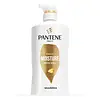What's inside
What's inside
 Key Ingredients
Key Ingredients

No key ingredients
 Benefits
Benefits

 Concerns
Concerns

 Ingredients Side-by-side
Ingredients Side-by-side

Water
Skin ConditioningSodium Lauroyl Methyl Isethionate
CleansingBabassuamidopropyl Hydroxysultaine
Skin ConditioningSodium Methyl Cocoyl Taurate
CleansingCetearyl Alcohol
EmollientCetyl Stearate
EmollientPropanediol
SolventSunfloweroyl Methylglucamide
CleansingJojoba Esters
EmollientHelianthus Annuus Seed Wax
Skin ConditioningMaltooligosyl Glucoside
Skin ConditioningPPG-20 Methyl Glucose Ether Distearate
EmollientChitosan
Hydroxypropyl Methylcellulose
Emulsion StabilisingSodium Cocoyl Glutamate
CleansingSodium Grapeseedamidopropyl Pg-Dimonium Chloride Phosphate
Skin ConditioningSodium Cocoyl Threoninate
CleansingOctafluoropentyl Methacrylate
Polyquaternium-47
Skin ConditioningMethylthiopropylamido Acetyl Methionine
Skin ProtectingBis-(Isostearoyl/Oleoyl Isopropyl) Dimonium Methosulfate
Skin ConditioningDisodium Cocoyl Glutamate
CleansingLauryl/Myristyl Polyricinoleate
EmollientHydrogenated Starch Hydrolysate
HumectantGlyceryl Caprylate/Caprate
EmollientPolyquaternium-22
Trisodium Ethylenediamine Disuccinate
Methylpropanediol
SolventGlycerin
HumectantPropylene Glycol
HumectantPotassium Cetyl Phosphate
EmulsifyingPEG-75 Shea Butter Glycerides
EmulsifyingPolyglycerin-3
HumectantPEG-120 Methyl Glucose Trioleate
CleansingAcrylates/C10-30 Alkyl Acrylate Crosspolymer
Emulsion StabilisingParfum
MaskingRosmarinus Officinalis Leaf Extract
AntimicrobialHelianthus Annuus Seed Oil
EmollientSodium Hydroxide
BufferingCitric Acid
BufferingEthylhexylglycerin
Skin ConditioningHydroxyacetophenone
AntioxidantLimonene
PerfumingHexyl Cinnamal
PerfumingLinalool
PerfumingCitronellol
PerfumingWater, Sodium Lauroyl Methyl Isethionate, Babassuamidopropyl Hydroxysultaine, Sodium Methyl Cocoyl Taurate, Cetearyl Alcohol, Cetyl Stearate, Propanediol, Sunfloweroyl Methylglucamide, Jojoba Esters, Helianthus Annuus Seed Wax, Maltooligosyl Glucoside, PPG-20 Methyl Glucose Ether Distearate, Chitosan, Hydroxypropyl Methylcellulose, Sodium Cocoyl Glutamate, Sodium Grapeseedamidopropyl Pg-Dimonium Chloride Phosphate, Sodium Cocoyl Threoninate, Octafluoropentyl Methacrylate, Polyquaternium-47, Methylthiopropylamido Acetyl Methionine, Bis-(Isostearoyl/Oleoyl Isopropyl) Dimonium Methosulfate, Disodium Cocoyl Glutamate, Lauryl/Myristyl Polyricinoleate, Hydrogenated Starch Hydrolysate, Glyceryl Caprylate/Caprate, Polyquaternium-22, Trisodium Ethylenediamine Disuccinate, Methylpropanediol, Glycerin, Propylene Glycol, Potassium Cetyl Phosphate, PEG-75 Shea Butter Glycerides, Polyglycerin-3, PEG-120 Methyl Glucose Trioleate, Acrylates/C10-30 Alkyl Acrylate Crosspolymer, Parfum, Rosmarinus Officinalis Leaf Extract, Helianthus Annuus Seed Oil, Sodium Hydroxide, Citric Acid, Ethylhexylglycerin, Hydroxyacetophenone, Limonene, Hexyl Cinnamal, Linalool, Citronellol
Water
Skin ConditioningSodium Lauryl Sulfate
CleansingSodium Laureth Sulfate
CleansingCocamidopropyl Betaine
CleansingGlycol Distearate
EmollientSodium Citrate
BufferingCocamide Mea
EmulsifyingSodium Xylenesulfonate
Dimethicone
EmollientParfum
MaskingSodium Chloride
MaskingCitric Acid
BufferingSodium Benzoate
MaskingTetrasodium EDTA
Guar Hydroxypropyltrimonium Chloride
Skin ConditioningPolyquaternium-6
Histidine
HumectantPanthenol
Skin ConditioningPanthenyl Ethyl Ether
Methylchloroisothiazolinone
PreservativeMethylisothiazolinone
PreservativeWater, Sodium Lauryl Sulfate, Sodium Laureth Sulfate, Cocamidopropyl Betaine, Glycol Distearate, Sodium Citrate, Cocamide Mea, Sodium Xylenesulfonate, Dimethicone, Parfum, Sodium Chloride, Citric Acid, Sodium Benzoate, Tetrasodium EDTA, Guar Hydroxypropyltrimonium Chloride, Polyquaternium-6, Histidine, Panthenol, Panthenyl Ethyl Ether, Methylchloroisothiazolinone, Methylisothiazolinone
 Reviews
Reviews

Alternatives
Ingredients Explained
These ingredients are found in both products.
Ingredients higher up in an ingredient list are typically present in a larger amount.
Citric Acid is an alpha hydroxy acid (AHA) naturally found in citrus fruits like oranges, lemons, and limes.
Like other AHAs, citric acid can exfoliate skin by breaking down the bonds that hold dead skin cells together. This helps reveal smoother and brighter skin underneath.
However, this exfoliating effect only happens at high concentrations (20%) which can be hard to find in cosmetic products.
Due to this, citric acid is usually included in small amounts as a pH adjuster. This helps keep products slightly more acidic and compatible with skin's natural pH.
In skincare formulas, citric acid can:
While it can provide some skin benefits, research shows lactic acid and glycolic acid are generally more effective and less irritating exfoliants.
Most citric acid used in skincare today is made by fermenting sugars (usually from molasses). This synthetic version is identical to the natural citrus form but easier to stabilize and use in formulations.
Read more about some other popular AHA's here:
Learn more about Citric AcidParfum is a catch-all term for an ingredient or more that is used to give a scent to products.
Also called "fragrance", this ingredient can be a blend of hundreds of chemicals or plant oils. This means every product with "fragrance" or "parfum" in the ingredients list is a different mixture.
For instance, Habanolide is a proprietary trade name for a specific aroma chemical. When used as a fragrance ingredient in cosmetics, most aroma chemicals fall under the broad labeling category of “FRAGRANCE” or “PARFUM” according to EU and US regulations.
The term 'parfum' or 'fragrance' is not regulated in many countries. In many cases, it is up to the brand to define this term.
For instance, many brands choose to label themselves as "fragrance-free" because they are not using synthetic fragrances. However, their products may still contain ingredients such as essential oils that are considered a fragrance by INCI standards.
One example is Calendula flower extract. Calendula is an essential oil that still imparts a scent or 'fragrance'.
Depending on the blend, the ingredients in the mixture can cause allergies and sensitivities on the skin. Some ingredients that are known EU allergens include linalool and citronellol.
Parfum can also be used to mask or cover an unpleasant scent.
The bottom line is: not all fragrances/parfum/ingredients are created equally. If you are worried about fragrances, we recommend taking a closer look at an ingredient. And of course, we always recommend speaking with a professional.
Learn more about ParfumWater. It's the most common cosmetic ingredient of all. You'll usually see it at the top of ingredient lists, meaning that it makes up the largest part of the product.
So why is it so popular? Water most often acts as a solvent - this means that it helps dissolve other ingredients into the formulation.
You'll also recognize water as that liquid we all need to stay alive. If you see this, drink a glass of water. Stay hydrated!
Learn more about Water